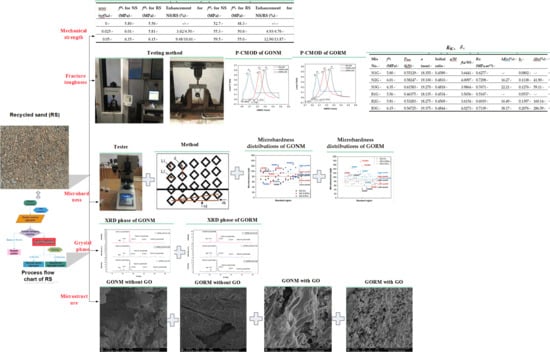Influence of Graphene Oxide on the Mechanical Properties, Fracture Toughness, and Microhardness of Recycled Concrete
Abstract
:1. Introduction
2. Materials and Experimental Details
2.1. Raw Materials
2.2. Preparation of GONM or GORM Specimens
2.3. Testing and Characterization Methods
3. Results and Discussion
3.1. Workability and Mechanical Properties
3.2. Fracture Toughness Properties
3.3. Microhardness
3.4. XRD and SEM Analysis
3.5. Improvement Mechanisms for the Mechanical Strength, Fracture Toughness, and Microhardness of GONM or GORM
4. Conclusions
Author Contributions
Funding
Acknowledgments
Conflicts of Interest
Abbreviations
| GO | Graphene oxide |
| CF | Carbon fiber |
| MKPC | Magnesium potassium phosphate cement |
| NS | Natural sand |
| RS | Recycled sand |
| GONM | GO-modified NS-based mortar |
| GORM | GO-modified RS-based mortar |
| SENB | Single edge notch bend |
| CMOD | Crack mouth opening displacement |
| XRD | X-ray powder diffraction |
| SEM | Scanning electronic microscopy |
| W/C | Water–cement ratio |
| S/C | Sand–cement ratio |
| AFt | Ettringite |
| CH | Calcium hydroxide |
| C-S-H | Calcium silicate hydrate |
References
- Li, Q.Y.; Gao, S.; Xue, S. Green Concrete Technology; China Building Materials Industry Press: Beijing, China, 2014. (In Chinese) [Google Scholar]
- Xiao, J.Z.; Sun, Y.D.; Falkner, H. Seismic performance of frame structures with recycled aggregate concrete. Eng. Struct. 2006, 28, 1–8. [Google Scholar] [CrossRef]
- Padmini, A.K.; Ramamurthy, K.; Mathews, M.S. Influence of parent concrete on the properties of recycled aggregate concrete. Constr. Build. Mater. 2009, 23, 829–836. [Google Scholar] [CrossRef]
- Yue, G.B.; Zhang, P.; Li, Q.Y.; Li, Q.Q. Performance analysis of a recycled concrete interfacial transition zone in a rapid carbonization environment. Adv. Mater. Sci. Eng. 2018, 2018, 1–8. [Google Scholar] [CrossRef]
- Poon, C.S.; Shui, Z.H.; Lam, L. Effect of microstructure of ITZ on compressive strength of concrete prepared with recycled aggregates. Constr. Build. Mater. 2004, 18, 461–468. [Google Scholar] [CrossRef]
- Kou, S.C.; Poon, C.S.; Chan, D. Influence of fly ash as cement replacement on the properties of recycled aggregate concrete. J. Mater. Civil Eng. 2007, 19, 709–717. [Google Scholar] [CrossRef]
- Tam, V.W.T.; Gao, X.F.; Tam, C.M. Microstructural analysis of recycles aggregate concrete produced from two stage mixing approach. Cem. Concr. Res. 2005, 35, 1195–1203. [Google Scholar] [CrossRef]
- Etxeberria, M.; Vazquez, E.; Mari, A. Microstructure analysis of hardened recycled aggregate concrete. Mag. Concr. Res. 2006, 58, 683–690. [Google Scholar] [CrossRef]
- Elsharief, A.; Cohen, M.D.; Olek, J. Influence of aggregate size, water cement ratio and age on the microstructure of the interfacial transition zone. Cem. Concr. Res. 2003, 33, 1837–1849. [Google Scholar] [CrossRef]
- Kong, D.Y.; Lei, T.; Zheng, J.J.; Ma, C.; Jiang, J.; Jiang, J. Effect and mechanism of surface-coating pozzalanics materials around aggregate on properties and ITZ microstructure of recycled aggregate concrete. Constr. Build. Mater. 2010, 24, 701–708. [Google Scholar] [CrossRef]
- Zhao, Z.H.; Wang, S.D.; Lu, L.C.; Gong, C.C. Evaluation of pre-coated recycled aggregate for concrete and mortar. Constr. Build. Mater. 2013, 43, 191–196. [Google Scholar] [CrossRef]
- Sallehan, I.; Mahyuddin, R. Mechanical strength and drying shrinkage properties of concrete containing treated coarse recycled concrete aggregates. Constr. Build. Mater. 2014, 68, 726–739. [Google Scholar]
- Zhu, Y.G.; Kou, S.C.; Poon, C.S.; Dai, J.G.; Li, Q.Y. Influence of silane-based water repellent on the durability properties of recycled aggregate concrete. Cem. Concr. Compos. 2013, 35, 32–38. [Google Scholar] [CrossRef]
- Man, D.L. Study on affection of the PVA fiber on recycled coarse aggregate to porous concrete performance. App. Mech. Mater. 2013, 438–439, 5–9. [Google Scholar] [CrossRef]
- Katkhuda, H.; Shatarat, N. Improving the mechanical properties of recycled concrete aggregate using chopped basalt fibers and acid treatment. Constr. Build. Mater. 2017, 140, 328–335. [Google Scholar] [CrossRef]
- Aly, M.; Hashmi, M.S.J.; Olabi, A.G.; Messeiry, M.; Abadir, E.F.; Hussain, A. Effect of colloidal nano-silica on the mechanical and physical behaviour of waste-glass cement mortar. Mater. Des. 2012, 33, 127–135. [Google Scholar] [CrossRef]
- Hosseini, P.; Booshehrian, A.; Madari, A. Developing concrete recycling strategies by utilization of nano-SiO2 particles. Waste Biomass Valori. 2011, 2, 347–355. [Google Scholar] [CrossRef]
- Ying, J.W.; Zhou, B.; Xiao, J.Z. Pore structure and chloride diffusivity of recycled aggregate concrete with nano-SiO2 and nano-TiO2. Constr. Build. Mater. 2017, 150, 49–55. [Google Scholar] [CrossRef]
- Qiu, L.; Yang, X.W.; Gou, X.L.; Yang, W.R.; Ma, Z.F.; Wallance, G.G.; Li, D. Dispersing carbon nanotubes with graphene oxide in water and synergistic effects between graphene derivatives. Chem. A Eur. J. 2010, 16, 10653–10658. [Google Scholar] [CrossRef] [PubMed]
- Long, W.J.; Li, H.D.; Fang, C.L.; Xing, F. Uniformly dispersed and re-agglomerated graphene oxide-based cement pastes: a comparison of rheological properties, mechanical properties and microstructure. Nanomaterials 2018, 8, 31. [Google Scholar] [CrossRef] [PubMed]
- Yan, X.T.; Cui, H.Z.; Qin, Q.H.; Tang, W.C.; Zhou, X.M. Study on utilization of carboxyl group decorated carbon nanotubes and carbonation reaction for improving strengths and microstructures of cement paste. Nanomaterials 2016, 6, 153. [Google Scholar] [CrossRef] [PubMed]
- Metaxa, Z.S.; Seo, J.W.T.; Konsta-Gdoutos, M.S.; Hersam, M.C.; Shah, S.P. Highly concentrated carbon nanotube admixture for nano-fiber reinforced cementitious materials. Cem. Concr. Compos. 2012, 34, 612–617. [Google Scholar] [CrossRef]
- Wang, Q.; Li, S.Y.; Pan, S.; Guo, Z.W. Synthesis and properties of a silane and copolymer-modified graphene oxide for use as a water-reducing agent in cement pastes. New Carbon Mater. 2018, 33, 131–139. [Google Scholar] [CrossRef]
- Ghazizadeh, S.; Duffour, P.; Skipper, N.T.; Bai, Y. Understanding the behaviour of graphene oxide in Portland cement paste. Cem. Concr. Res. 2018, 111, 169–182. [Google Scholar] [CrossRef]
- Roy, R.; Mitra, A.; Ganesh, A.T.; Sairam, V. Effect of graphene oxide nanosheets dispersion in cement mortar composites incorporating metakaolin and silica fume. Constr. Build. Mater. 2018, 186, 514–524. [Google Scholar] [CrossRef]
- Shang, Y.; Zhang, D.; Yang, C.; Liu, Y.Y.; Liu, Y. Effect of graphene oxide on the rheological properties of cement pastes. Constr. Build. Mater. 2015, 96, 20–28. [Google Scholar] [CrossRef]
- Hou, D.S.; Lu, Z.Y.; Li, X.C.; Ma, H.Y.; Li, Z.J. Reactive molecular dynamics and experimental study of graphene-cement composites: Structure, dynamics and reinforcement mechanisms. Carbon 2017, 115, 188–208. [Google Scholar] [CrossRef]
- Gong, K.; Pan, Z.; Korayem, A.H.; Qiu, L.; Li, D.; Collins, F.; Wang, C.M.; Duan, W.H. Reinforcing effects of graphene oxide on portland cement paste. J. Mater. Civil Eng. 2015, 27, 1–6. [Google Scholar] [CrossRef]
- Lv, S.H.; Ting, S.; Liu, J.J.; Zhou, Q.F. Use of graphene oxide nanosheets to regulate the microstructure of hardened cement paste to increase its strength and toughness. Cryst. Eng. Comm. 2014, 16, 8508–8516. [Google Scholar] [CrossRef]
- Sharma, S.; Kothiyal, N.C. Influence of graphene oxide as dispersed phase in cement mortar matrix in defining the crystal patterns of cement hydrates and its effect on mechanical, microstructural and crystallization properties. RSC Adv. 2015, 5, 52642–52657. [Google Scholar] [CrossRef]
- Lu, Z.Y.; Hou, D.S.; Meng, L.S.; Sun, G.X.; Lu, C.; Li, Z.J. Mechanism of cement paste reinforced by graphene oxide/carbon nanotubes composites with enhanced mechanical properties. RSC Adv. 2015, 5, 100598–100605. [Google Scholar] [CrossRef]
- Pan, Z.; He, L.; Qiu, L.; Korayema, A.H.; Li, G.; Zhu, J.W.; Collins, F.; Li, D.; Duan, W.H.; Wang, M.C. Mechanical properties and microstructure of a graphene oxide–cement composite. Cem. Concr. Compos. 2015, 58, 140–147. [Google Scholar] [CrossRef]
- Lv, S.H.; Ma, Y.J.; Qiu, C.C.; Sun, T.; Liu, J.J.; Zhou, Q.F. Effect of graphene oxide nanosheets of microstructure and mechanical properties of cement composites. Constr. Build. Mater. 2013, 49, 121–127. [Google Scholar] [CrossRef]
- Lu, C.; Lu, Z.Y.; Li, Z.J.; Leung, C.K.Y. Effect of graphene oxide on the mechanical behavior of strain hardening cementitious composites. Constr. Build. Mater. 2016, 120, 457–464. [Google Scholar] [CrossRef]
- Dimov, D.; Amit, I.; Gorrie, O.; Barnes, M.D.; Townsend, N.J.; Neves, A.I.S.; Withers, F.; Russo, S.; Craciun, M.F. Ultrahigh performance nanoengineered graphene–concrete composites for multifunctional applications. Adv. Funct. Mater. 2018, 28, 1705183–1705194. [Google Scholar] [CrossRef]
- Long, W.J.; Wei, J.J.; Xing, F.; Khayat, K.H. Enhanced dynamic mechanical properties of cement paste modified with graphene oxide nanosheets and its reinforcing mechanism. Cem. Concr. Compos. 2018, 93, 127–139. [Google Scholar] [CrossRef]
- Wang, Q.; Wang, J.; Lu, C.X.; Liu, B.W.; Zhang, K.; Li, C.Z. Influence of graphene oxide additions on the microstructure and mechanical strength of cement. Carbon 2015, 95, 1083–1084. [Google Scholar] [CrossRef]
- Lu, L.; Ouyang, D. Properties of cement mortar and ultra-high strength concrete incorporating graphene oxide nanosheets. Nanomaterials 2017, 7, 187. [Google Scholar] [CrossRef] [PubMed]
- Liu, J.T.; Fu, J.L.; Ni, T.Y.; Yang, Y. Fracture toughness improvement of multi-wall carbon nanotubes /graphene sheets reinforced cement paste. Constr. Build. Mater. 2019, 200, 530–538. [Google Scholar] [CrossRef]
- Peng, H.; Ge, Y.P.; Cai, C.S.; Zhang, Y.X.; Liu, Z. Mechanical properties and microstructure of graphene oxide cement-based composites. Constr. Build. Mater. 2019, 194, 102–109. [Google Scholar] [CrossRef]
- Mohammed, A.; Sanjayan, J.G.; Duan, W.H.; Nazari, A. Incorporating graphene oxide in cement composites: A study of transport properties. Constr. Build. Mater. 2015, 84, 341–347. [Google Scholar] [CrossRef]
- Mohammed, A.; Sanjayan, J.G.; Duan, W.H.; Nazari, A. Graphene oxide impact on hardened cement expressed in enhanced freeze–thaw resistance. J. Mater. Civil Eng. 2016, 28, 1586–1592. [Google Scholar] [CrossRef]
- Chen, J.; Zhao, D.; Ge, H.Y.; Wang, J. Graphene oxide-deposited carbon fiber/cement composites for electromagnetic interference shielding application. Constr. Build. Mater. 2015, 84, 66–72. [Google Scholar] [CrossRef]
- Sun, S.W.; Ding, S.Q.; Han, B.G.; Dong, S.F.; Yu, X.; Zhou, D.B.; Ou, J.P. Multi-layer graphene-engineered cementitious composites with multifunctionality/intelligence. Compos. Part B Eng. 2017, 129, 221–232. [Google Scholar] [CrossRef]
- Lu, Z.Y.; Hou, D.S.; Ma, H.Y.; Fan, T.Y.; Li, Z.J. Effects of graphene oxide on the properties and microstructures of the magnesium potassium phosphate cement paste. Constr. Build. Mater. 2016, 119, 107–112. [Google Scholar] [CrossRef]
- Li, X.Y.; Wang, L.H.; Liu, Y.Q.; Li, W.G.; Dong, B.Q.; Duan, W.H. Dispersion of graphene oxide agglomerates in cement paste and its effects on electrical resistivity and flexural strength. Cem. Concr. Compos. 2018, 92, 145–154. [Google Scholar] [CrossRef]
- Gao, Y.; Jing, H.W.; Chen, S.J.; Du, M.R.; Chen, W.Q.; Duan, W.H. Influence of ultrasonication on the dispersion and enhancing effect of graphene oxide–carbon nanotube hybrid nanoreinforcement in cementitious composite. Compos. Part B Eng. 2019, 164, 45–53. [Google Scholar] [CrossRef]
- Lu, L.C.; Zhao, P.Q.; Lu, Z.Y. A short discussion on how to effectively use graphene oxide to reinforce cementitious composites. Constr. Build. Mater. 2018, 189, 33–41. [Google Scholar] [CrossRef]
- Test Methods of Fluidity of Cement Mortar; Chinese National Standard GB/T2419-2005; Standards Press of China: Beijing, China, 2005. (In Chinese)
- Luo, J.L.; Duan, Z.D.; Xian, G.J.; Li, Q.Y.; Zhao, T.J. Fabrication and fracture toughness properties of carbon nanotube-reinforced cement composite. Eur. Phys. J. Appl. Phys. 2011, 53, 304–310. [Google Scholar] [CrossRef]
- Luo, J.L.; Li, Q.Y.; Zhao, T.J.; Gao, S.; Sun, S.W. Bonding and toughness properties of PVA fibre reinforced aqueous epoxy resin cement repair mortar. Constr. Build. Mater. 2013, 49, 766–771. [Google Scholar] [CrossRef]
- Standard test method for microindentation hardness of materials; ASTM International ASTM E384-08; ASTM: West Conshohocken, PA, USA, 2008.
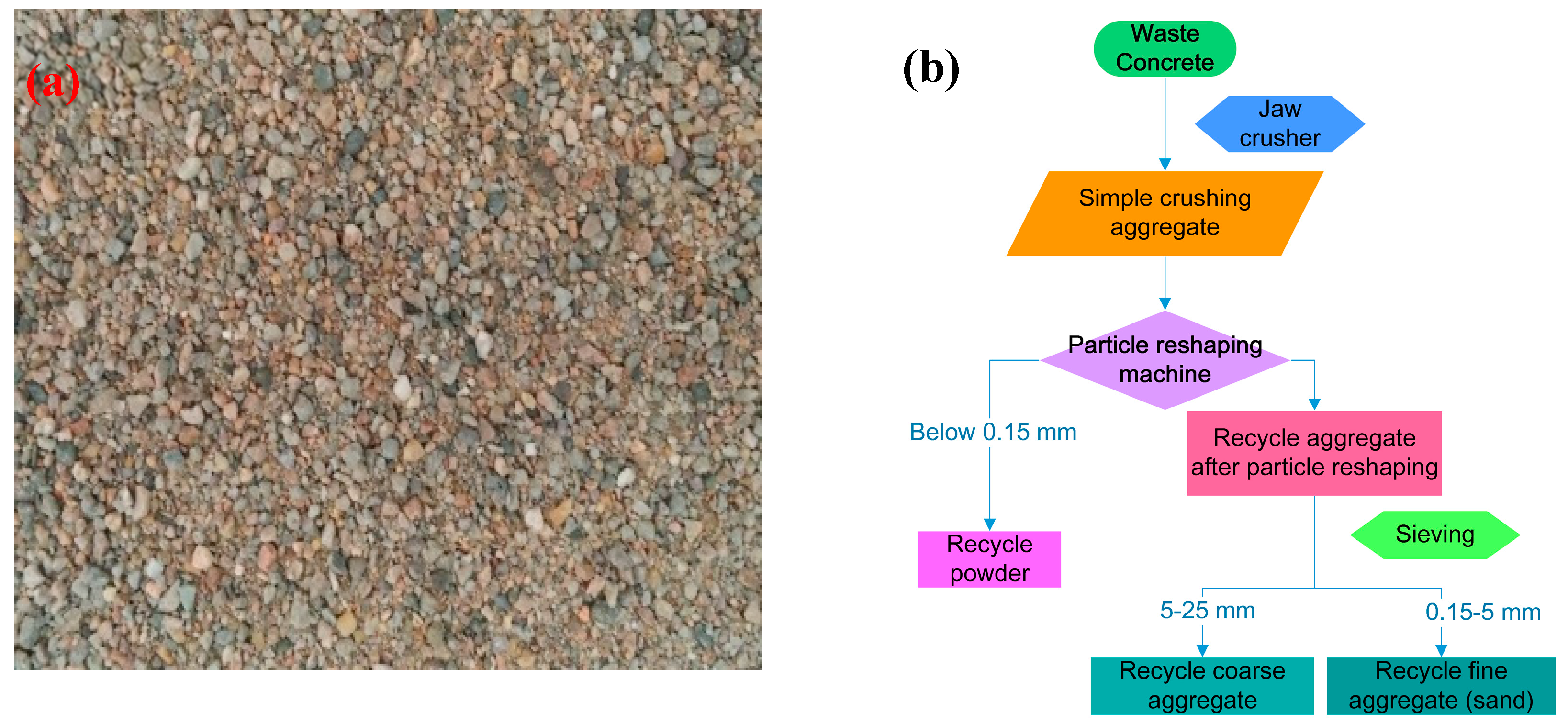
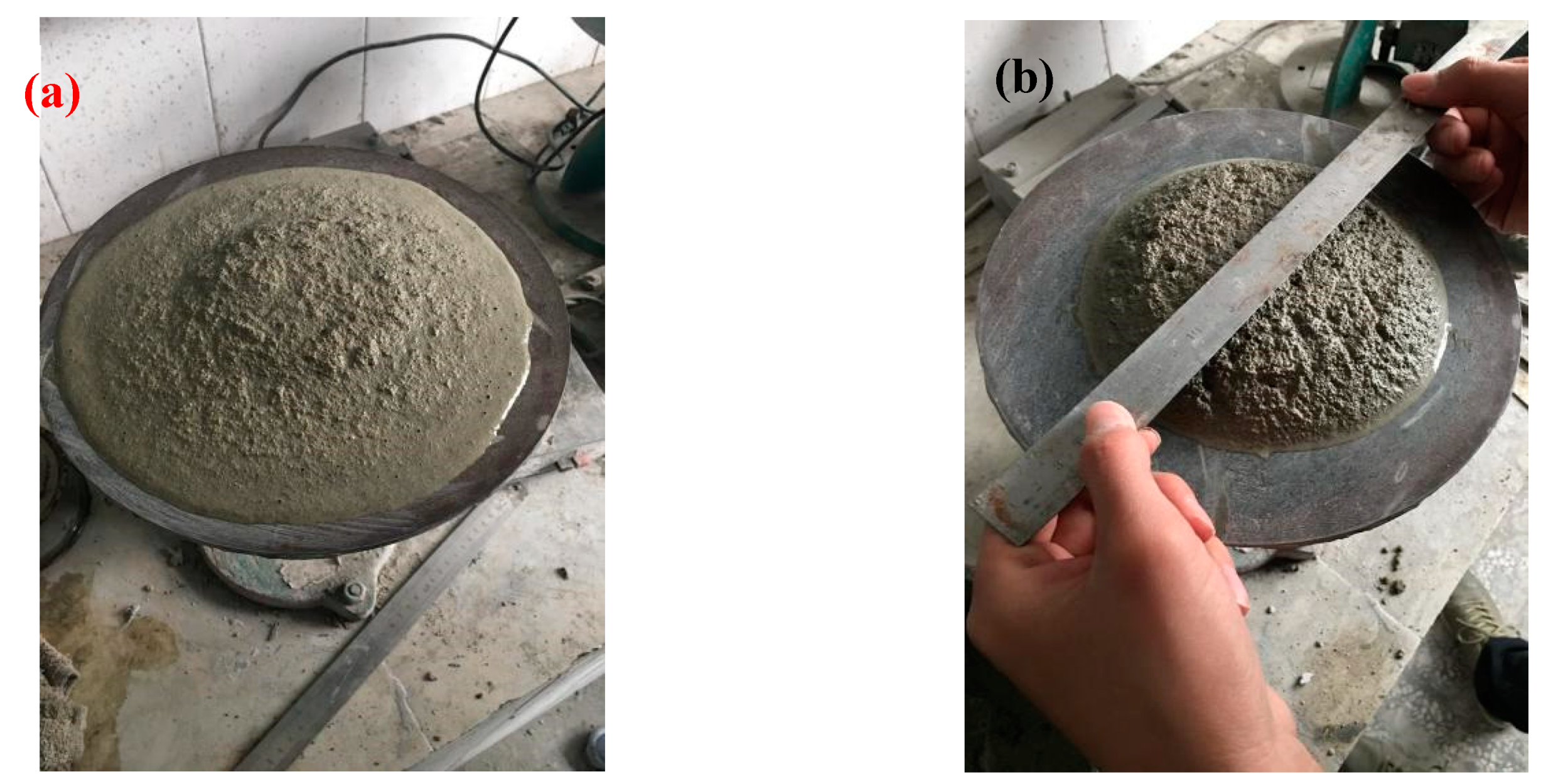

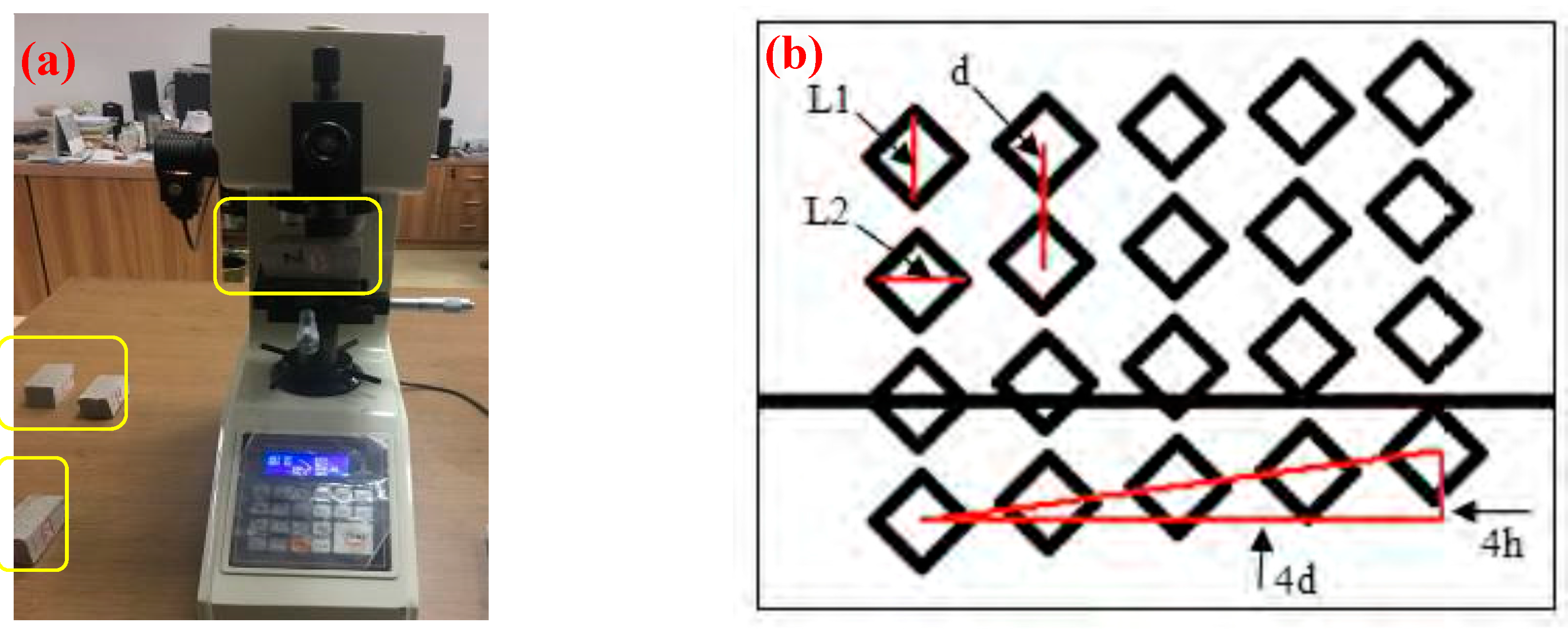



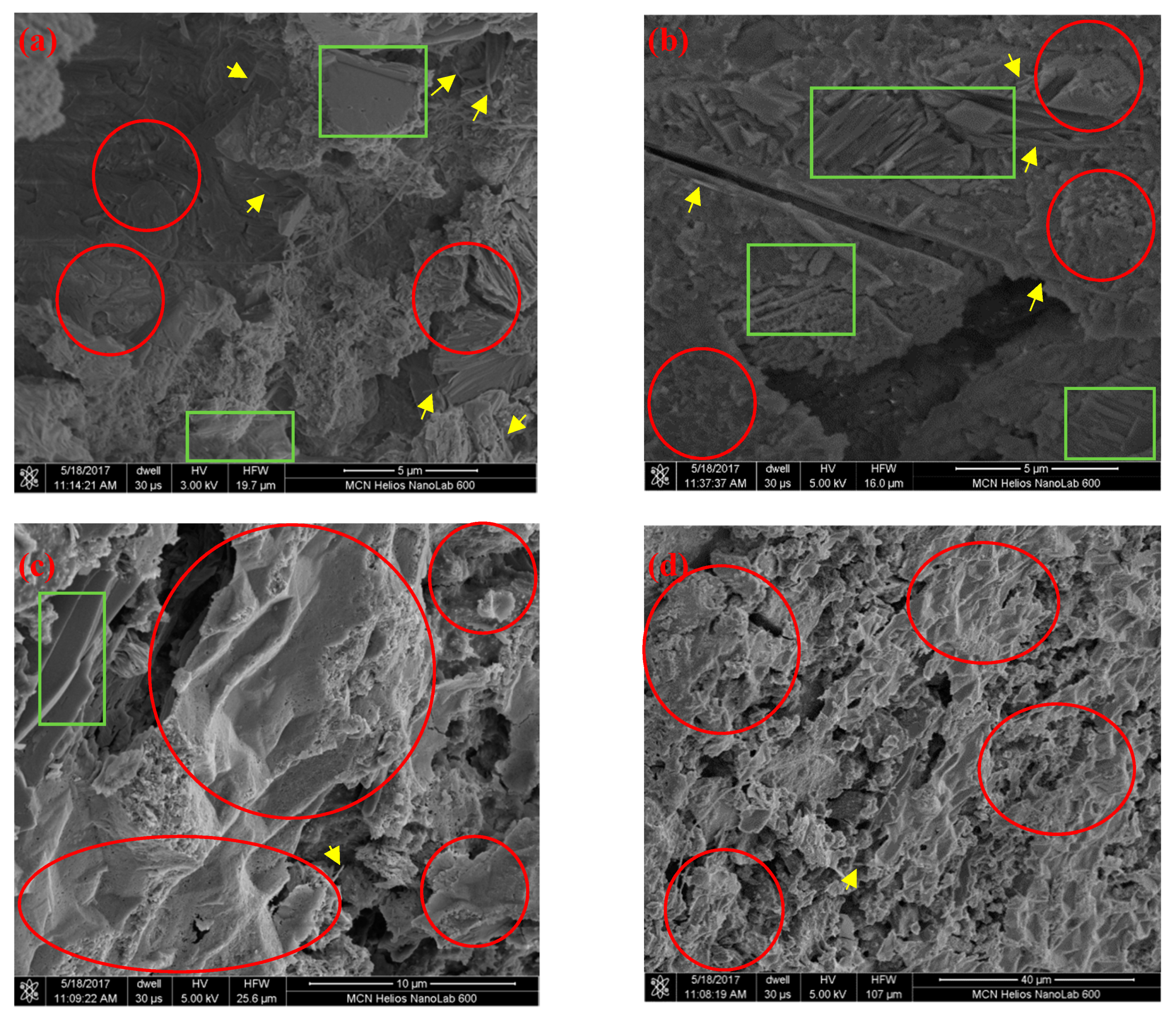
| Comp.(wt%) | SiO2 | Al2O3 | CaO | MgO | SO3 | Fe2O3 | K2O | Na2O | Loss on Ignition | |
| Type | ||||||||||
| P.I. 52.5 | 20.87 | 4.87 | 64.47 | 2.13 | 2.52 | 3.59 | 0.65 | 0.11 | 0.77 | |
| Phys. Index | Density (g/cm3) | Brunauer-Emmett-Teller Surface (g/m2) | Soundness | Setting Time (min) | Flexural Strength (MPa) | Compressive Strength (MPa) | ||||
| Type | Initial | Final | 3 d | 28 d | 3 d | 28 d | ||||
| P.I. 52.5 | 3.15 | 458.0 | Qualified | 175 | 255 | 4.0 | 7.0 | 23.9 | 52.5 | |
| Sieve size (mm) | 4.75 | 2.36 | 1.18 | 0.6 | 0.3 | 0.15 | Sieve Bottom |
|---|---|---|---|---|---|---|---|
| Cumulative screening (%) | 4.6 | 16.8 | 33 | 59.8 | 89.6 | 99.2 | 99.8 |
| Fineness Modulus | Apparent Density (kg/m3) | Bulk Density (kg/m3) | Water Absorption (%) | Clay Content (%) | Crushing Index (%) |
|---|---|---|---|---|---|
| 2.70 | 2503 | 1469 | 49–56 | 41–50 | 22.3 |
| Superplasticizer | Solid Content (%) | pH Value | Water Reduction (%) | Air-entraining Content (%) | Alkali Content (%) |
| Polycarboxylate-type | 30 | 6.5–8 | 25–35 | 2–5 | ≤0.2 |
| PristineGO Dispersion | Concentration | Monolayer Content | Dispersant | Flake Diameter (nm) | Oxygen Content (%) |
| XF020 | 1 mg/mL | >95% | water | <500 | 41–50 |
| wt% | Water | Superplasticizer | NS | RS | GO | Flowability (mm) | |
|---|---|---|---|---|---|---|---|
| Mix No. | |||||||
| N1G | 0.40 | 0.015 | 2.0 | 0 | 0 | 187 | |
| N2G | 0.0025 | 166 | |||||
| N3G | 0.005 | 128 | |||||
| R1G | 0 | 2.0 | 0 | 182 | |||
| R2G | 0.0025 | 159 | |||||
| R3G | 0.005 | 121 | |||||
| wGO (wt‰) | f28t for NS (MPa) | f28t for RS (MPa) | Enhancement for NS/RS (%) | f28c for NS (MPa) | f28c for RS (MPa) | Enhancement for NS/RS (%) |
|---|---|---|---|---|---|---|
| 0 | 5.80 | 5.56 | -/- | 52.7 | 48.3 | -/- |
| 0.025 | 6.01 | 5.81 | 3.62/4.50 | 55.3 | 50.6 | 4.93/4.76 |
| 0.05 | 6.35 | 6.15 | 9.48/10.61 | 59.5 | 55.0 | 12.90/13.87 |
| Mix No. | f28t (MPa) | Pmax (kN) | a (mm) | Initial a/W ratio | f(a/W) | KIC (MPa.m1/2) | ΔKIC (%) | Critical CMOD (δc) | Δδc (%) |
|---|---|---|---|---|---|---|---|---|---|
| N1G | 5.80 | 0.55129 | 18.355 | 0.4589 | 3.6441 | 0.6277 | - | 0.0802 | - |
| N2G | 6.01 | 0.58247 | 19.330 | 0.4833 | 4.0097 | 0.7298 | 16.27 | 0.1138 | 41.90 |
| N3G | 6.35 | 0.61583 | 19.270 | 0.4818 | 3.9864 | 0.7671 | 22.21 | 0.1276 | 59.11 |
| R1G | 5.56 | 0.46375 | 18.135 | 0.4534 | 3.5656 | 0.5167 | - | 0.0537 | - |
| R2G | 5.81 | 0.53283 | 18.275 | 0.4569 | 3.6154 | 0.6019 | 16.49 | 0.1397 | 160.14 |
| R3G | 6.15 | 0.56725 | 19.375 | 0.4844 | 4.0273 | 0.7139 | 38.17 | 0.2076 | 286.59 |
© 2019 by the authors. Licensee MDPI, Basel, Switzerland. This article is an open access article distributed under the terms and conditions of the Creative Commons Attribution (CC BY) license (http://creativecommons.org/licenses/by/4.0/).
Share and Cite
Luo, J.; Chen, S.; Li, Q.; Liu, C.; Gao, S.; Zhang, J.; Guo, J. Influence of Graphene Oxide on the Mechanical Properties, Fracture Toughness, and Microhardness of Recycled Concrete. Nanomaterials 2019, 9, 325. https://doi.org/10.3390/nano9030325
Luo J, Chen S, Li Q, Liu C, Gao S, Zhang J, Guo J. Influence of Graphene Oxide on the Mechanical Properties, Fracture Toughness, and Microhardness of Recycled Concrete. Nanomaterials. 2019; 9(3):325. https://doi.org/10.3390/nano9030325
Chicago/Turabian StyleLuo, Jianlin, Shuaichao Chen, Qiuyi Li, Chao Liu, Song Gao, Jigang Zhang, and Junbing Guo. 2019. "Influence of Graphene Oxide on the Mechanical Properties, Fracture Toughness, and Microhardness of Recycled Concrete" Nanomaterials 9, no. 3: 325. https://doi.org/10.3390/nano9030325
APA StyleLuo, J., Chen, S., Li, Q., Liu, C., Gao, S., Zhang, J., & Guo, J. (2019). Influence of Graphene Oxide on the Mechanical Properties, Fracture Toughness, and Microhardness of Recycled Concrete. Nanomaterials, 9(3), 325. https://doi.org/10.3390/nano9030325




